Numerical Investigation of Droplet Impact on Stationary and Horizontal Moving Surfaces with Superhydrophobic Micro-Pillar Structures
Abstract
1. Introduction
2. Numerical Method
2.1. Physical Model
2.2. Numerical Solution
2.3. Governing Equations
2.4. Model Validation
3. Results and Discussion
3.1. Droplet Impact on a Stationary Micropillar Surface
3.2. Droplet Impact on Horizontally Moving Micro-Pillar Surfaces
3.2.1. Droplet Impact Behavior
3.2.2. Velocity Restitution Coefficient and Energy Dissipation
3.2.3. Maximum Spreading Diameter
3.2.4. Contact Time
4. Conclusions
- Under the operational conditions of this study on a stationary surface, unlike millimeter-sized droplets, micrometer-sized droplets cannot detach from the micro-pillar surface in either the Cassie or Wenzel states, achieving surface detachment only in the partial penetration state. Based on numerical simulation results, a dimensionless maximum spreading diameter formula for droplets impacting stationary micro-pillar surfaces is obtained, which can be expressed as
- In the process of droplets impacting horizontally moving micro-pillar structured surfaces, significant rolling phenomena occur when droplets are in the Cassie state, which leads to an increase in viscous dissipation and forms a competitive mechanism with the asymmetric spreading–retraction process of the droplets. This compromise effect influences the contact time and velocity restitution coefficient of the droplets. Moreover, the changes in contact time and velocity restitution coefficient exhibit distinct two-stage characteristics, providing new insights into understanding the dynamic behavior of droplets on microstructured surfaces.
- Through systematic parameter studies, it can be concluded that when micrometer-sized droplets impact horizontally moving micro-pillar structured surfaces, the dimensionless maximum spreading diameter is linearly proportional to Wet. Based on extensive numerical simulation data, a new correlation is fitted asThis model provides a theoretical basis for predicting the dynamic behavior of micrometer-sized droplets on microstructured surfaces.
Author Contributions
Funding
Institutional Review Board Statement
Informed Consent Statement
Data Availability Statement
Conflicts of Interest
References
- Wang, X.; Xu, B.; Guo, S.; Zhao, Y.; Chen, Z. Droplet impacting dynamics: Recent progress and future aspects. Adv. Colloid Interface Sci. 2023, 317, 102919. [Google Scholar] [CrossRef] [PubMed]
- Wang, D.; Sun, Q.; Hokkanen, M.J.; Zhang, C.; Lin, F.; Liu, Q.; Zhu, S.; Zhou, T.; Chang, Q.; He, B.; et al. Design of robust superhydrophobic surfaces. Nature 2020, 582, 55–59. [Google Scholar] [CrossRef] [PubMed]
- Breitenbach, J.; Roisman, I.V.; Tropea, C. From drop impact physics to spray cooling models: A critical review. Exp. Fluids 2018, 59, 55. [Google Scholar] [CrossRef]
- Cao, L.; Jones, A.K.; Sikka, V.K.; Wu, J.; Gao, D. Anti-Icing Superhydrophobic Coatings. Langmuir 2009, 25, 12444–12448. [Google Scholar] [CrossRef]
- Sirringhaus, H.; Kawase, T.; Friend, R.H.; Shimoda, T.; Inbasekaran, M.; Wu, W.; Woo, E.P. High-resolution inkjet printing of all-polymer transistor circuits. Science 2000, 290, 2123–2126. [Google Scholar] [CrossRef]
- Yang, C.; Yuan, Y.J. Investigation on the mechanism of nitrogen plasma modified PDMS bonding with SU-8. Appl. Surf. Sci. 2016, 364, 815–821. [Google Scholar] [CrossRef]
- Mateo, J.N.; Kulkarni, S.S.; Das, L.; Bandyopadhyay, S.; Tepper, G.C.; Wynne, K.J.; Bandyopadhyay, S. Wetting behavior of polymer coated nanoporous anodic alumina films: Transition from super-hydrophilicity to super-hydrophobicity. Nanotechnology 2011, 22, 35703. [Google Scholar] [CrossRef]
- Sun, M.; Li, X.; Ding, B.; Yu, J.; Sun, G. Mechanical and wettable behavior of polyacrylonitrile reinforced fibrous polystyrene mats. J. Colloid Interface Sci. 2010, 347, 147–152. [Google Scholar] [CrossRef]
- Ong, Q.K.; Sokolov, I. Attachment of nanoparticles to the AFM tips for direct measurements of interaction between a single nanoparticle and surfaces. J. Colloid Interface Sci. 2007, 310, 385–390. [Google Scholar] [CrossRef]
- Chou, S.Y.; Keimel, C.; Gu, J. Ultrafast and direct imprint of nanostructures in silicon. Nature 2002, 417, 835–837. [Google Scholar] [CrossRef]
- Song, J.; Gao, M.; Zhao, C.; Lu, Y.; Huang, L.; Liu, X.; Carmalt, C.J.; Deng, X.; Parkin, I.P. Large-Area Fabrication of Droplet Pancake Bouncing Surface and Control of Bouncing State. ACS Nano 2017, 11, 9259–9267. [Google Scholar] [CrossRef] [PubMed]
- Quan, Y.; Zhang, L. Numerical and Analytical Study of The Impinging and Bouncing Phenomena of Droplets on Superhydrophobic Surfaces with Microtextured Structures. Langmuir 2014, 30, 11640–11649. [Google Scholar] [CrossRef] [PubMed]
- Liu, Y.; Moevius, L.; Xu, X.; Qian, T.; Yeomans, J.M.; Wang, Z. Pancake bouncing on superhydrophobic surfaces. Nat. Phys. 2014, 10, 515–519. [Google Scholar] [CrossRef] [PubMed]
- Rothstein, J.P. Slip on Superhydrophobic Surfaces. Annu. Rev. Fluid Mech. 2010, 42, 89–109. [Google Scholar] [CrossRef]
- Ukiwe, C.; Kwok, D.Y. On the Maximum Spreading Diameter of Impacting Droplets on Well-Prepared Solid Surfaces. Langmuir 2005, 21, 666–673. [Google Scholar] [CrossRef]
- Rioboo, R.; Voué, M.; Vaillant, A.; De Coninck, J. Drop impact on porous superhydrophobic polymer surfaces. Langmuir ACS J. Surf. Colloids 2008, 24, 14074–14077. [Google Scholar] [CrossRef]
- Wang, Z.; Lopez, C.; Hirsa, A.; Koratkar, N. Impact dynamics and rebound of water droplets on superhydrophobic carbon nanotube arrays. Appl. Phys. Lett. 2007, 91, 23105. [Google Scholar] [CrossRef]
- Kwon, D.H.; Huh, H.K.; Lee, S.J. Wetting state and maximum spreading factor of microdroplets impacting on superhydrophobic textured surfaces with anisotropic arrays of pillars. Exp. Fluids 2013, 54, 1576. [Google Scholar] [CrossRef]
- Wang, Y.; Chen, S. Droplets impact on textured surfaces: Mesoscopic simulation of spreading dynamics. Appl. Surf. Sci. 2015, 327, 159–167. [Google Scholar] [CrossRef]
- Zhang, R.; Hao, P.; He, F. Drop Impact on Oblique Superhydrophobic Surfaces with Two-Tier Roughness. Langmuir 2017, 33, 3556–3567. [Google Scholar] [CrossRef]
- Liu, Y.; Whyman, G.; Bormashenko, E.; Hao, C.; Wang, Z. Controlling drop bouncing using surfaces with gradient features. Appl. Phys. Lett. 2015, 107, 51604. [Google Scholar] [CrossRef]
- Lv, C.; Hao, P.; Zhang, X.; He, F. Drop impact upon superhydrophobic surfaces with regular and hierarchical roughness. Appl. Phys. Lett. 2016, 108, 141602. [Google Scholar] [CrossRef]
- Zhang, R.; Hao, P.; Zhang, X.; Niu, F.; He, F. Tunable Droplet Breakup Dynamics on Micropillared Superhydrophobic Surfaces. Langmuir 2018, 34, 7942–7950. [Google Scholar] [CrossRef] [PubMed]
- Gao, S.; Liao, Q.; Liu, W.; Liu, Z. Nanodroplets Impact on Rough Surfaces: A Simulation and Theoretical Study. Langmuir ACS J. Surf. Colloids 2018, 34, 5910–5917. [Google Scholar] [CrossRef]
- Wang, L.; Zhou, A.; Zhou, J.; Chen, L.; Yu, Y. Droplet impact on pillar-arrayed non-wetting surfaces. Soft Matter 2021, 17, 5932–5940. [Google Scholar] [CrossRef]
- Andrew, M.; Liu, Y.; Yeomans, J.M. Variation of the Contact Time of Droplets Bouncing on Cylindrical Ridges with Ridge Size. Langmuir ACS J. Surf. Colloids 2017, 33, 7583–7587. [Google Scholar] [CrossRef]
- Gauthier, A.; Symon, S.; Clanet, C.; Quéré, D. Water impacting on superhydrophobic macrotextures. Nat. Commun. 2015, 6, 8001. [Google Scholar] [CrossRef]
- Bird, J.C.; Dhiman, R.; Kwon, H.; Varanasi, K.K. Reducing the contact time of a bouncing drop. Nature 2013, 503, 385–388. [Google Scholar] [CrossRef]
- Liu, C.; Liu, Q.; Lin, Z. Dynamical behavior of droplets transiently impacting on superhydrophobic microstructures. Phys. Fluids 2020, 32, 103304. [Google Scholar] [CrossRef]
- Lin, D.; Wang, L.; Wang, X.; Yan, W. Reduction in the contact time of impacting droplets by decorating a rectangular ridge on superhydrophobic surfaces. Int. J. Heat Mass Transf. 2019, 132, 1105–1115. [Google Scholar] [CrossRef]
- Zhang, X.; Zhu, Z.; Zhang, C.; Yang, C. Reduced contact time of a droplet impacting on a moving superhydrophobic surface. Appl. Phys. Lett. 2020, 117, 151602. [Google Scholar] [CrossRef]
- Hao, J.; Green, S.I. Splash threshold of a droplet impacting a moving substrate. Phys. Fluids 2017, 29, 12103. [Google Scholar] [CrossRef]
- Chen, R.H.; Wang, H.W. Effects of tangential speed on low-normal-speed liquid drop impact on a non-wettable solid surface. Exp. Fluids 2005, 39, 754–760. [Google Scholar] [CrossRef]
- Almohammadi, H.; Amirfazli, A. Understanding the drop impact on moving hydrophilic and hydrophobic surfaces. Soft Matter 2017, 13, 2040–2053. [Google Scholar] [CrossRef]
- Buksh, S.; Almohammadi, H.; Marengo, M.; Amirfazli, A. Spreading of low-viscous liquids on a stationary and a moving surface. Exp. Fluids 2019, 60, 76. [Google Scholar] [CrossRef]
- Raman, K.A. Normal and oblique droplet impingement dynamics on moving dry walls. Phys. Rev. E 2019, 99, 53108. [Google Scholar] [CrossRef]
- Zhan, H.; Lu, C.; Liu, C.; Wang, Z.; Lv, C.; Liu, Y. Horizontal Motion of a Superhydrophobic Substrate Affects the Drop Bouncing Dynamics. Phys. Rev. Lett. 2021, 126, 234503. [Google Scholar] [CrossRef]
- Cheng, Y.; Lu, S.; Xu, W.; Wen, H.; Wang, J. Fabrication of superhydrophobic Au–Zn alloy surface on a zinc substrate for roll-down, self-cleaning and anti-corrosion properties. J. Mater. Chem. A 2015, 3, 16774–16784. [Google Scholar] [CrossRef]
- Boreyko, J.B.; Chen, C. Restoring Superhydrophobicity of Lotus Leaves with Vibration-Induced Dewetting. Phys. Rev. Lett. 2009, 103, 174502. [Google Scholar] [CrossRef]
- Wei, W.; Ji, C.; Fangye, L.; Zou, J.; Dorbolo, S. Water drops bouncing off vertically vibrating textured surfaces. J. Fluid Mech. 2019, 876, 1041–1051. [Google Scholar]
- Huber, R.A.; Campbell, M.; Doughramaji, N.; Derby, M.M. Vibration-enhanced droplet motion modes: Simulations of rocking, ratcheting with breakup, and ejection. J. Fluids Eng. 2019, 141, 071105. [Google Scholar]
- Pillai, R.; Borg, M.K.; Reese, J.M. Dynamics of Nanodroplets on Vibrating Surfaces. Langmuir ACS J. Surf. Colloids 2018, 34, 11898–11904. [Google Scholar] [CrossRef]
- Raman, K.A.; Jaiman, R.K.; Sui, Y.; Lee, T.; Low, H. Rebound suppression of a droplet impacting on an oscillating horizontal surface. Phys. Rev. E 2016, 94, 23108. [Google Scholar] [CrossRef]
- Mettu, S.; Chaudhury, M.K. Motion of Drops on a Surface Induced by Thermal Gradient and Vibration. Langmuir 2008, 24, 10833–10837. [Google Scholar] [CrossRef] [PubMed]
- Moradi, M.; Rahimian, M.H.; Chini, S.F. Numerical simulation of droplet impact on vibrating low-adhesion surfaces. Phys. Fluids 2020, 32, 62110. [Google Scholar] [CrossRef]
- Hee Kwon, D.; Joon Lee, S. Impact and wetting behaviors of impinging microdroplets on superhydrophobic textured surfaces. Appl. Phys. Lett. 2012, 100, 171601. [Google Scholar] [CrossRef]
- Sussman, M.; Puckett, E.G. A Coupled Level Set and Volume-of-Fluid Method for Computing 3D and Axisymmetric Incompressible Two-Phase Flows. J. Comput. Phys. 2000, 162, 301–337. [Google Scholar] [CrossRef]
- Hirt, C.W.; Nichols, B.D. Volume of fluid (VOF) method for the dynamics of free boundaries. J. Comput. Phys. 1981, 39, 201–225. [Google Scholar] [CrossRef]
- Osher, S.; Sethian, J.A. Fronts propagating with curvature-dependent speed: Algorithms based on Hamilton-Jacobi formulations. J. Comput. Phys. 1988, 79, 12–49. [Google Scholar] [CrossRef]
- Dai, X.; Zhang, W.; Zhang, J.; Xin, G.; Wang, X. Numerical study of droplet impact on superhydrophobic vibrating surfaces with microstructures. Case Stud. Therm. Eng. 2022, 30, 101732. [Google Scholar] [CrossRef]
- Field, J.E. ELSI conference: Invited lecture: Liquid impact: Theory, experiment, applications. Wear 1999, 233–235, 1–12. [Google Scholar] [CrossRef]
- Deng, T.; Varanasi, K.K.; Hsu, M.; Bhate, N.; Keimel, C.; Stein, J.; Blohm, M. Nonwetting of impinging droplets on textured surfaces. Appl. Phys. Lett. 2009, 94, 133109. [Google Scholar] [CrossRef]
- Richard, D. Contact time of a bouncing drop. Nature 2002, 417, 811. [Google Scholar]
- Qian, L.; Huo, B.; Chen, Z.; Li, E.; Ding, H. Droplet bouncing on moving superhydrophobic groove surfaces. Int. J. Multiph. Flow 2023, 165, 104454. [Google Scholar] [CrossRef]
- Aboud, D.G.K.; Kietzig, A. Influence of Microstructure Topography on the Oblique Impact Dynamics of Drops on Superhydrophobic Surfaces. Langmuir 2021, 37, 4678–4689. [Google Scholar] [CrossRef]
- Shu, Y.; Hu, Z.; Feng, Y.; Wu, X.; Dong, Z.; Chu, F. Prince Rupert’s Drop bouncing on high-speed moving superhydrophobic surfaces. Int. Commun. Heat Mass Transf. 2023, 148, 107049. [Google Scholar] [CrossRef]
- Xia, L.; Yang, Z.; Chen, F.; Liu, T.; Tian, Y.; Zhang, D. Droplet impacting on pillared hydrophobic surfaces with different solid fractions. J. Colloid Interface Sci. 2024, 658, 61–73. [Google Scholar] [CrossRef]
- Biance, A.; Chevy, F.; Clanet, C.; Lagubeau, G.; Quéré, D. On the elasticity of an inertial liquid shock. J. Fluid Mech. 2006, 554, 47–66. [Google Scholar]
- Aria, A.I.; Gharib, M. Physicochemical Characteristics and Droplet Impact Dynamics of Superhydrophobic Carbon Nanotube Arrays. Langmuir 2014, 30, 6780–6790. [Google Scholar] [CrossRef]
- Aboud, D.; Kietzig, A. On the Oblique Impact Dynamics of Drops on Superhydrophobic Surfaces. Part II: Restitution Coefficient and Contact Time. Langmuir 2018, 34, 9889–9896. [Google Scholar] [CrossRef]
- Hu, A.; Liu, D. 3D simulation of micro droplet impact on the structured superhydrophobic surface. Int. J. Multiph. Flow 2022, 147, 103887. [Google Scholar] [CrossRef]
- Liu, Y.; Andrew, M.; Li, J.; Yeomans, J.M.; Wang, Z. Symmetry breaking in drop bouncing on curved surfaces. Nat. Commun. 2015, 6, 10034. [Google Scholar] [CrossRef]



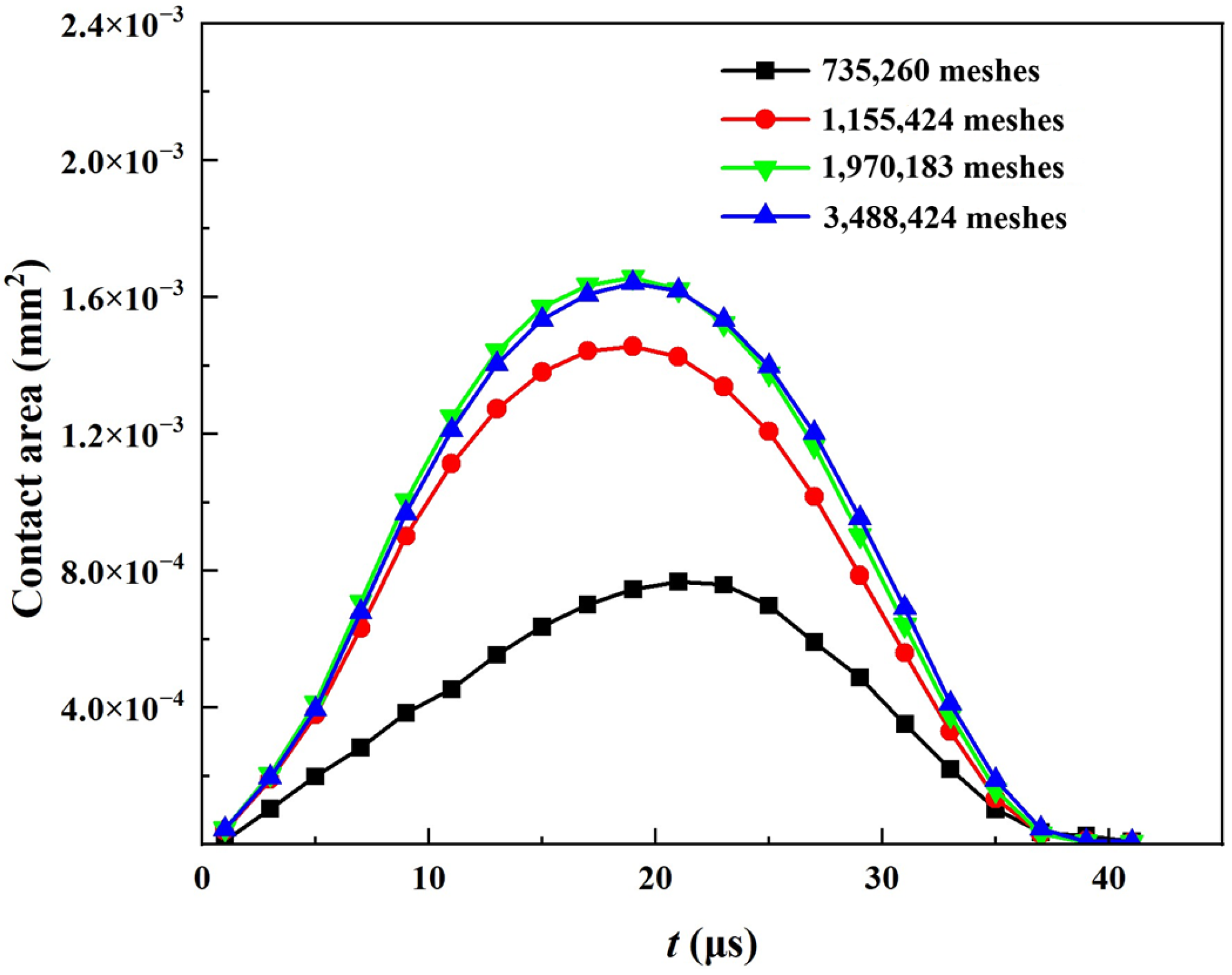


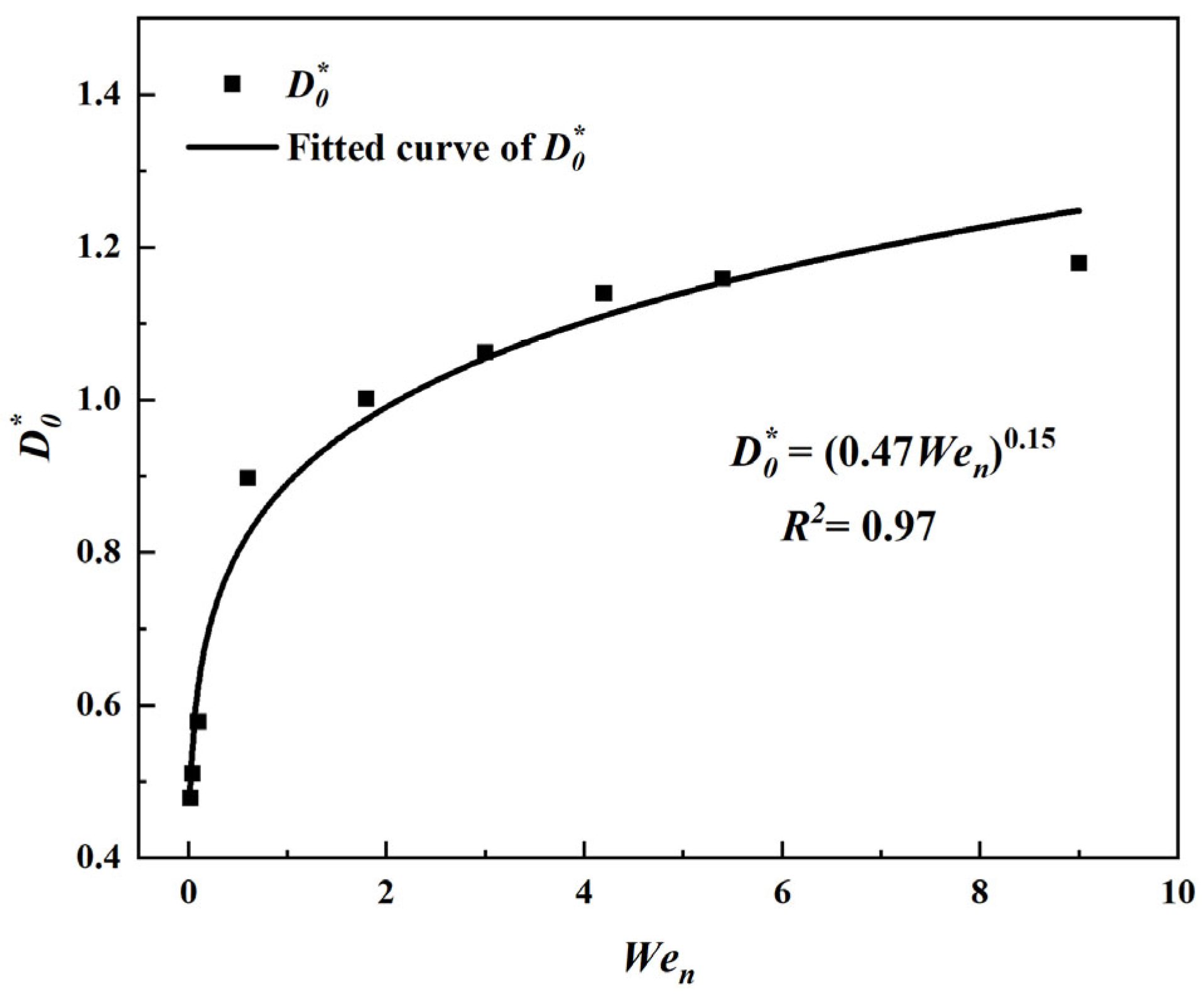
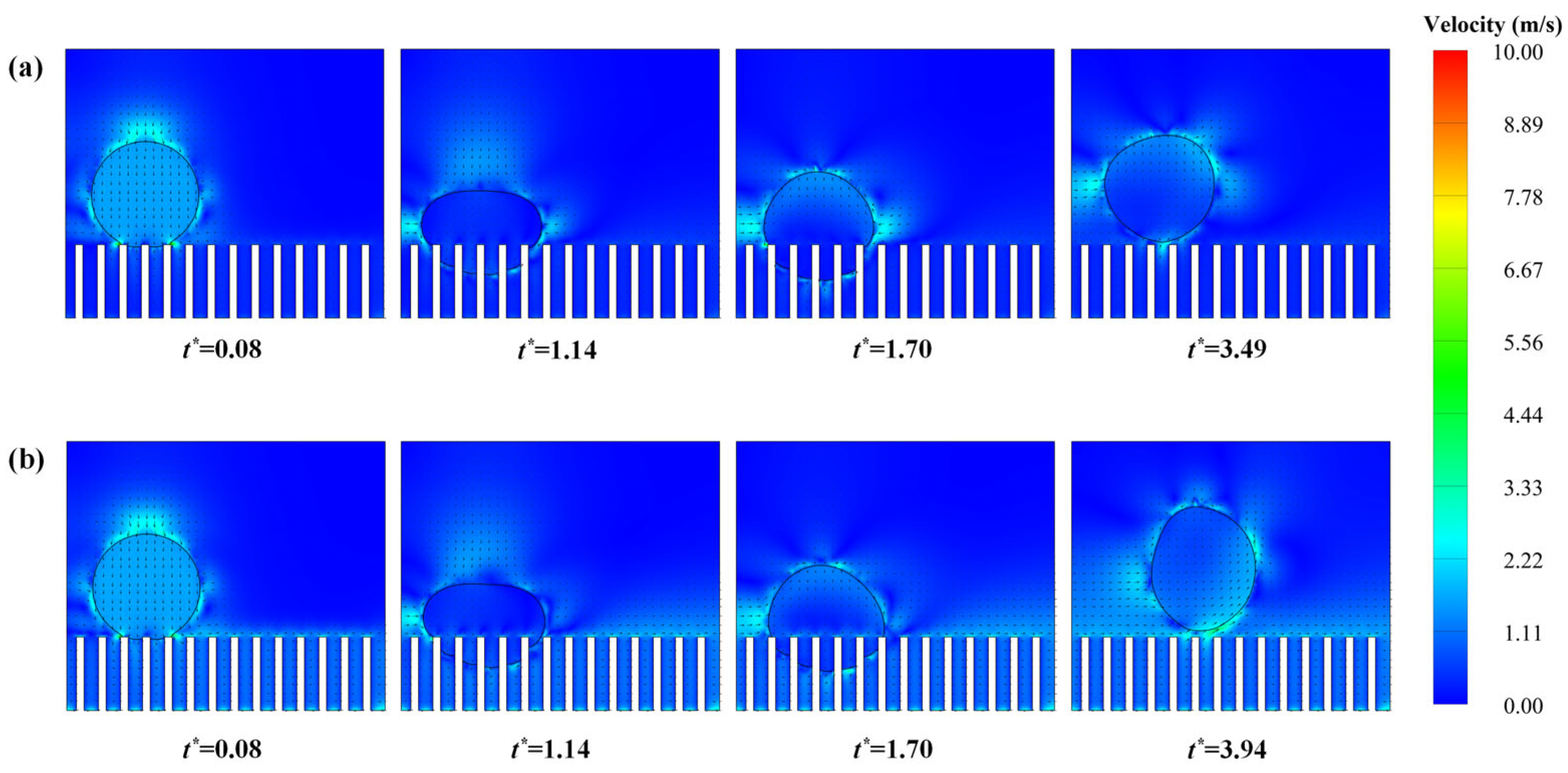



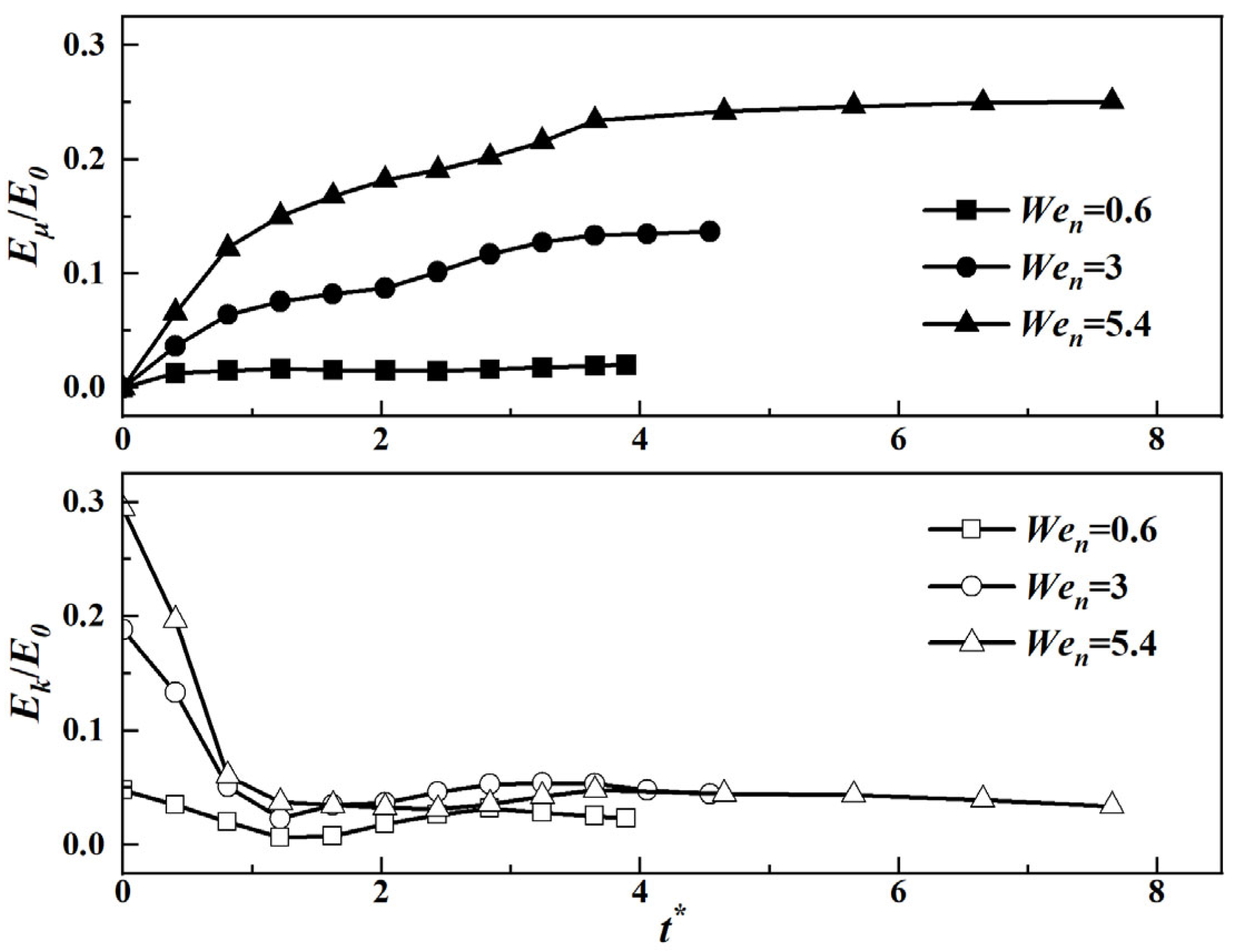
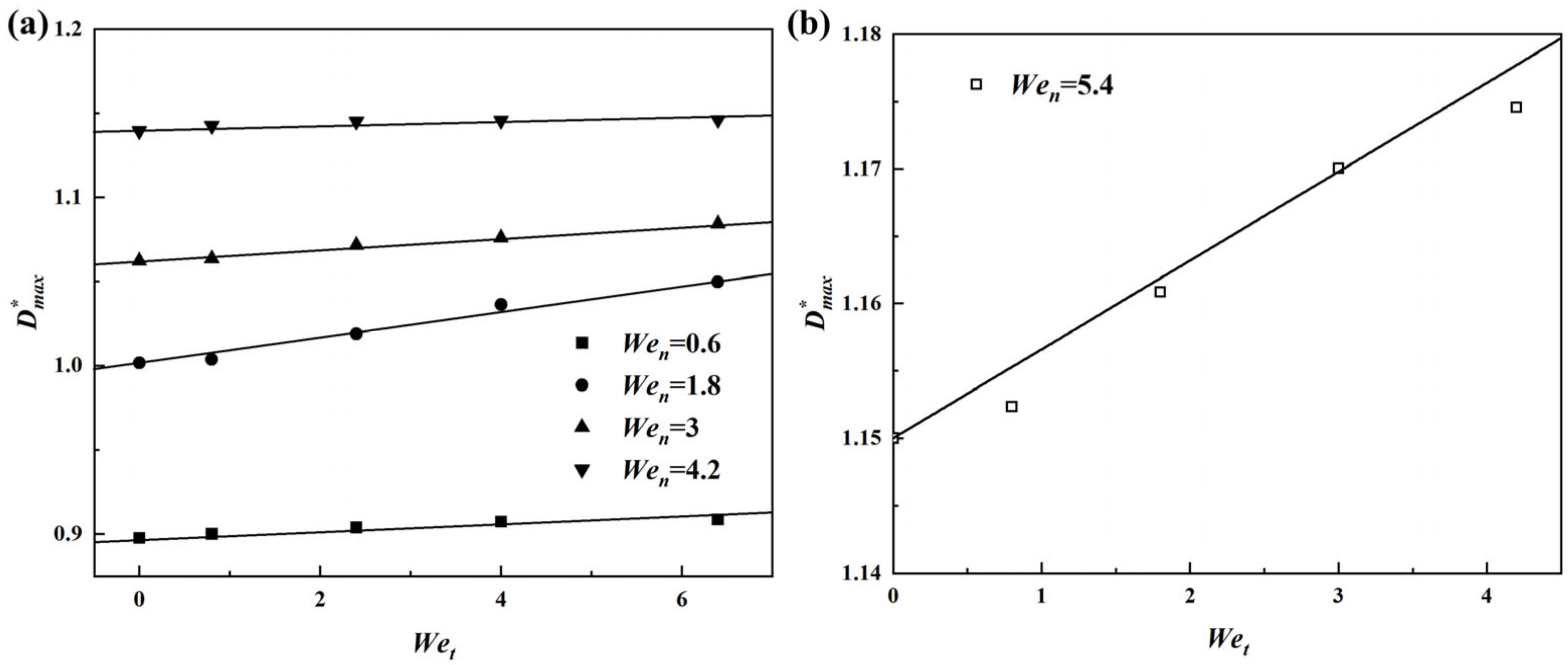
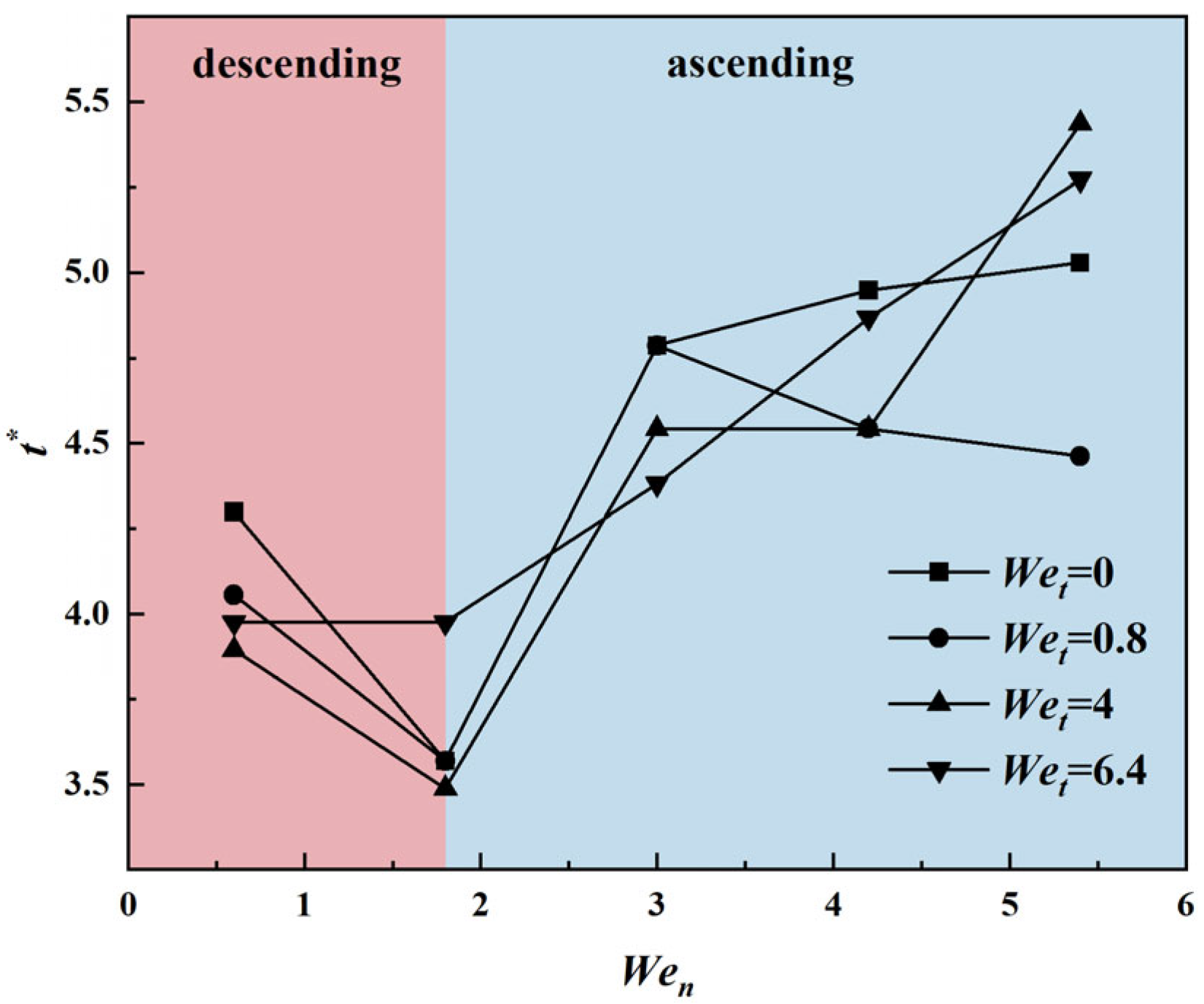
Disclaimer/Publisher’s Note: The statements, opinions and data contained in all publications are solely those of the individual author(s) and contributor(s) and not of MDPI and/or the editor(s). MDPI and/or the editor(s) disclaim responsibility for any injury to people or property resulting from any ideas, methods, instructions or products referred to in the content. |
© 2025 by the authors. Licensee MDPI, Basel, Switzerland. This article is an open access article distributed under the terms and conditions of the Creative Commons Attribution (CC BY) license (https://creativecommons.org/licenses/by/4.0/).
Share and Cite
Zhang, H.; Jia, F.; Wei, M. Numerical Investigation of Droplet Impact on Stationary and Horizontal Moving Surfaces with Superhydrophobic Micro-Pillar Structures. Appl. Sci. 2025, 15, 3188. https://doi.org/10.3390/app15063188
Zhang H, Jia F, Wei M. Numerical Investigation of Droplet Impact on Stationary and Horizontal Moving Surfaces with Superhydrophobic Micro-Pillar Structures. Applied Sciences. 2025; 15(6):3188. https://doi.org/10.3390/app15063188
Chicago/Turabian StyleZhang, Haibin, Fuxing Jia, and Min Wei. 2025. "Numerical Investigation of Droplet Impact on Stationary and Horizontal Moving Surfaces with Superhydrophobic Micro-Pillar Structures" Applied Sciences 15, no. 6: 3188. https://doi.org/10.3390/app15063188
APA StyleZhang, H., Jia, F., & Wei, M. (2025). Numerical Investigation of Droplet Impact on Stationary and Horizontal Moving Surfaces with Superhydrophobic Micro-Pillar Structures. Applied Sciences, 15(6), 3188. https://doi.org/10.3390/app15063188





